

Institute for Hazards Planning Mitigation and Research. Disasters can be viewed as natural or man-made acts that are outside human control.
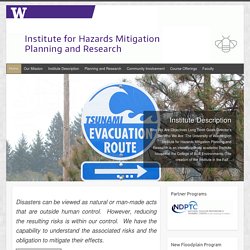
However, reducing the resulting risks is within our control. We have the capability to understand the associated risks and the obligation to mitigate their effects. The Institute is dedicated to integrating hazards mitigation principles into a wide range of crisis, disaster, and risk management opportunities. Its mission is to build a resource center that will enhance risk reduction activities through research and analysis of hazards, policies related to mitigation and through outreach to the community. The Institute provides expertise in disaster preparedness, response and recovery with a special emphasis on mitigation and planning in the promotion of community sustainability. Welcome -The National Emergency Management Association. Atmosphere Page. Temperature: Global – Ground and Sea Surface Temperature Naval Research Laboratory (NRL) Monterey Marine Meteorology Division – Click the pic to view at source Global Surface Temperature Anomalies National Oceanic & Atmospheric Administration (NOAA) – Earth System Research Laboratory (ESRL) – Click the pic to view at source.
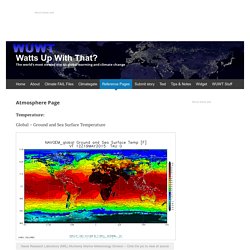
Floods: Recurrence intervals and 100-year floods. The USGS Water Science School Possibly you can remember when a really big rain, be it from a hurricane or a large frontal system, hit your town.
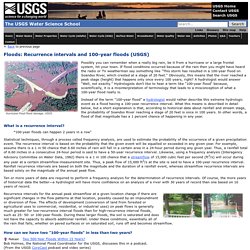
If flood conditions occurred because of the rain then you might have heard the radio or TV weatherman say something like "This storm has resulted in a 100-year flood on Soandso River, which crested at a stage of 20 feet. " Who is Frank Luntz? Four Stages of Emergency Management - FEMA. Whats in a Name? Global Warming vs. Climate Change. What’s In A Name? Global Warming vs Climate Change. We found that the term "global warming" is associated with greater public understanding, emotional engagement, and support for personal and national action than the term "climate change.
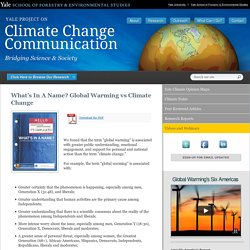
" For example, the term “global warming” is associated with: Our findings strongly suggest that the terms global warming and climate change are used differently and mean different things in the minds of many Americans. The following graphic shows how the two terms elicit different meanings for Americans. Further, Americans are four times more likely to say they hear the term global warming in public discourse than climate change. Disaster Resilience: A National Imperative - Susan Cutter. Stockholm Resilience Centre - Stockholm Resilience Centre. C. S. Holling. Crawford Stanley (Buzz) Holling, OC (born December 6, 1930) is a Canadian ecologist, and Emeritus Eminent Scholar and Professor in Ecological Sciences at the University of Florida.
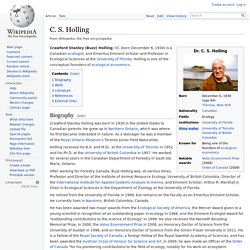
Holling is one of the conceptual founders of ecological economics. Biography[edit] Crawford Stanley Holling was born in 1930 in the United States to Canadian parents. Ecology and Society - C.S. Holling. Yale Project on Climate Change. National Studies The Climate Change in the American Mind Project The public plays a critical role in the American response to global warming through their energy use at home and on the road, consumer choices, social norms, and political support for climate policies and leaders.

This project: 1) investigates, explains, and tracks public understanding of the causes, consequences, and solutions to climate change, support for climate policies, and the current barriers to action, and 2) designs and tests new strategies to engage the public in climate science and solutions. "Everything We Do is a Disaster!" Economic Benefits of a Disaster-Resistant University. The Economic Benefits of a Disaster-Resistant University Disasters affect universities across the country.
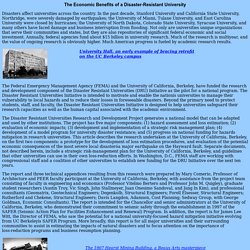
In the past decade, Stanford University and California State University, Northridge, were severely damaged by earthquakes; the University of Miami, Tulane University, and East Carolina University were closed by hurricanes; the University of North Dakota, Colorado State University, Syracuse University, and many others have faced damage and business interruption from flooding. Building a Disaster-Resistant University. Follow FEMA: Start of content.
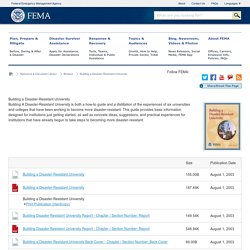
+Share/Email This Page Building a Disaster-Resistant University Main Content. Crisis Response and Disaster Resilience 2030: Forging Strategic Action in an Age of Uncertainty. FEMA Disaster Assistance Reform Act of 2015. Bill Tracker: This bill has the status Introduced Here are the steps for Status of Legislation: IntroducedArray ( [0] => Array ( [externalActionCode] => 1000 [displayText] => oracle.sql.NCLOB@2833b471 [description] => Introduced [actionDate] => 2015-03-19 ) ) Passed HousePassed SenateTo PresidentBecame Law Shown Here:Introduced in House (03/19/2015)

Feds to require climate change plans for states seeking disaster relief. A new Federal Emergency Management Agency policy requiring states to address climate change before they can become eligible for grant funding is drawing fire from congressional Republicans.
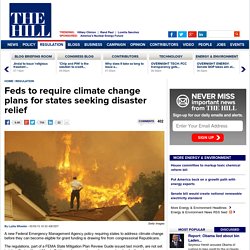
The regulations, part of a FEMA State Mitigation Plan Review Guide issued last month, are not set to take effect until next March. But lawmakers are demanding an explanation for the rules now. In a letter to FEMA Administrator W. Craig Fugate, the lawmakers said they’re concerned that the agency’s decision will create unnecessary red tape in the disaster preparedness process. Oregon Resilience Plan. What a Chief Resilience Officer Does. One critical step cities can take to facilitate their resilience building is to hire a Chief Resilience Officer (CRO). The CRO is an innovative position in city government that ideally reports directly to the city’s chief executive, and acts as the city's point person for resilience building, helping to coordinate all of the city's resilience efforts. But what exactly does that mean? With so many cities' CROs getting to work, we wanted to go into a little more detail about what makes a CRO.
CROs are an important part of how we're trying to solve two major problems cities face: First, cities are complex systems made of an array of smaller, distinct actors like government agencies, local businesses, and offices of international organizations; and they often don’t communicate or interact with one another as much as they should; Second, the solutions cities develop are often not treated as scalable knowledge. UW Urban Design and Planning. Center for Sustainable Infrastructure. The Center for Sustainable Infrastructure focuses squarely on advancing a new sustainable infrastructure paradigm and practice in the Northwest and beyond.
Read the Inaugural Report This report distills the themes and insights from interviews of 70 top infrastructure innovators and provides inspiration and guidance to future infrastructure leaders. Donate to the Center Give Now Infrastructure—for many people it’s a boring word. Masters Thesis.